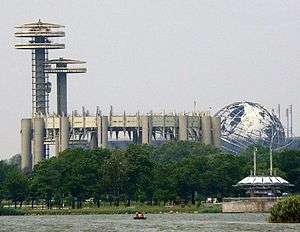Queens Theatre in the Park
Queens Theatre, formerly Queens Theatre in the Park and before that Queens Playhouse is an American professional theatre, located in Flushing Meadows–Corona Park, Queens, New York City, New York. Artistic and Executive Directors have included Joseph S. Kutrzeba, founder and producer; Robert Moss, Sue Lawless, Jeffrey Rosenstock and Ray Cullom, formerly Managing Director of Long Wharf Theatre in New Haven, CT, and currently, Taryn Sacramone, former Executive Director of Astoria Performing Arts Center.[1]
Theaterama (adapted from) | |
.jpg) Queens Theatre | |

| |
| Address | Flushing Meadows–Corona Park Flushing, New York United States |
|---|---|
| Coordinates | 40°44′38.98″N 73°50′39.92″W |
| Type | Regional theater |
| Construction | |
| Opened | 1964 |
| Architect | Philip Johnson and Richard Foster |
| Website | |
| queenstheatre.org | |
History
| Attractions and Geographical Features of Flushing Meadows–Corona Park |
 |
Attractions and geographical features of Flushing Meadows–Corona Park: 1 2 3 4 5 6 7 8 9 10 11 12 13 14 |
Adapted from the former Theaterama at the 1964 New York World's Fair, the theater was part of Philip Johnson's then $6 million construction project that also included observation towers and an open-air pavilion called the "Tent of Tomorrow". The theater was originally decorated with the artworks including those of Andy Warhol and Robert Indiana. The site had also hosted the 1939 New York World's Fair.
The theater is next to the Unisphere at Flushing Meadows–Corona Park, an area that also includes Citi Field, the Queens Museum of Art, and the USTA Billie Jean King National Tennis Center.[2]
Johnson and Richard Foster designed the original theater. The audience stood and viewed a travelog of New York State projected on screens lining the inside of the circular room.[3] The showing of a cycloramic (360 degrees) film about New York State was a tribute to the world fair's host city.
The surround cinema was converted into a multipurpose "legitimate" theater in the 1970s, requiring the addition of a stage, public restrooms, lobby, dressing rooms, and stage house.[3]
1972 - 1975
The Queens Playhouse as it was then known upon its opening in 1972, was founded by Joseph S. Kutrzeba in 1965 in a lumberyard in Bayside, Queens, was the first nonprofit professional resident theater in Queens. Their first production in the new theater was George Bernard Shaw's Pygmalion.[4] The theatre suffered financial setbacks in 1974, Kutrzeba blaming a lack of support by the New York State Council on the Arts and the Queens Cultural Association.[5] In November 1974, Kutrzeba left Queens Theatre to pursue a career as a Broadway producer with The Lieutenant, a musical based on the trials resulting from the Mỹ Lai Massacre.[6] The production had started at the Queens Playhouse before it moved to Broadway where it was nominated for a Tony Award for Best Musical but closed after a short run.[7]
1985–93 conversion
The circular theater closed in 1985. A $4 million project converted it into a 476-seat community theater, designed by architect Alfredo De Vido, opened in 1993.[2][3][8][9] The conversion was a "wonderful success" according to Queens Borough President Claire Shulman, who said she was an attendee at the 1939 World's Fair (held at the same site) as a little girl.[10]
It became known as the Queens Theatre in the Park. The theater is now used for cabaret, concerts, Broadway revivals, new productions, and film festivals.[11] The playhouse hosts various drama, dance, music, performance art, troupe, and comedy performances as well as children’s events. A 100-seat theater "for more experimental fare" is located downstairs of the main theater. The theater has been a venue for the Independent Film Showcase and is intended to meet the various interests of the diverse population of Queens.[12] The work completed in 1993 improved acoustics and added a public elevator, additional lighting and rigging, "front-of-house catwalks", and reworked the facades. The original dome was strengthened and a second roof added, abating noise from nearby LaGuardia Airport. A 100-seat "flexible studio theater" was also added in the downstairs.[3]
The operators of the theater became an independent nonprofit in 1997. A member of the Cultural Institutions Group, it is funded in part from the New York City Department of Cultural Affairs and hosts approximately 300 events a year.
During the 1996–97 season it had attendance of 90,000 people at more than 300 performances of theater, music, dance, children's shows and workshops, films and festivals. In an effort to reach Latinos, a Latin American festival was hosted.[2] The 1964–1965 New York World's Fair New York State Pavilion was listed on the National Register of Historic Places in 2009.[13]
2008–10 addition
A 2008–10 addition, designed by Caples Jefferson Architects with Lee/Timchula Architects, added a reception hall. A transparent circular pavilion, it is said to be "especially dramatic at twilight, when the sunset-colored, invert dome appears to hover and flow in the dark."[14]
A 600-person "nebula" reception space was part of a restoration project completed in 2010. Architects involved included Caples Jefferson Architects.[15][16][17]
In 2009 the theater was added to the National Register of Historic Places as one of the 3 qualifying structures that make up the New York State Pavilion from the 1964 New York World's Fair.[18][19]
In popular culture
The exterior of the pavilion was used in the musical film The Wiz (1978), directed by Sidney Lumet; and the final scene of the science-fiction, action comedy film Men in Black (1997), directed by Barry Sonnenfeld.[3]
References
- Times Ledger, "Queens Theatre in the Park chooses new exec director" New York Post, March 3, 2011
- Ruiz, Albor (July 21, 1997). "Swing Thru Latin America Via Fest". Daily News. Retrieved August 16, 2012.
- David C. Berliner, "Queens Playhouse Opening", The New York Times, October 29, 1972
- Louis Calta, "Dispute Over Queens Theater" The New York Times, October 20, 1974
- Louis Calta, "Producer of Queens Playhouse Resigns", The New York Times, November 17, 1974
- "Tony Award Nominee from Queens", The New York Times, April 6, 1975
- Staff (undated). "History of Queens Theatre". Queens Theatre in the Park. Retrieved August 16, 2012.
- Alfredo De Vido Selected and Current Works
- Dunlap, David (August 26, 2001). "A Queens Park's Past Shapes Its Future". The New York Times. Retrieved August 16, 2012.
- Queens Theatre in the Park; New York State Pavilion, Flushing Meadows Corona Park,Corona, NY 11368 Cinema Treasures
- [NYC Arts website]
- "National Register of Historic Places". National Register of Historic Places. June 25, 2010.
- "Queens Theatre Park'. Openhousenewyork.
- "Queens-Theatre-in-the-Park". Archived from the original on April 24, 2012. Retrieved April 28, 2012.
- Queens Theater in the Park / Caples Jefferson June 13, 2011 Arch Daily
- Boniface, Russell (January 23, 2009). "Queens Theatre-in-the-Park Continues Spirit of Philip Johnson's Cylindrical Geometries" Archived May 12, 2012, at the Wayback Machine. AIArchitect (American Institute of Architects). Retrieved August 16, 2012.
- Nicholas Hirshon, "New York State Pavilion, relic of the 1964 World's Fair in Queens, wins approval as landmark", New York Daily News, September 15, 2009
- National Register of Historic Places, "1964 New York World's Fair New York State Pavilion", National Archives and Records Administration
